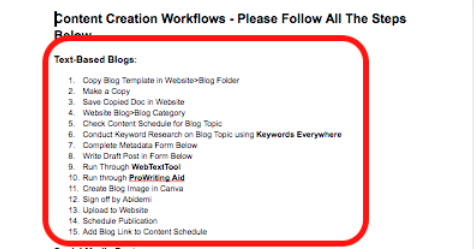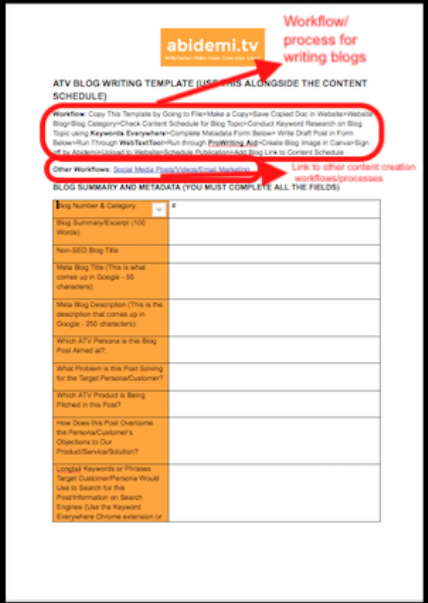
Implement this secret in your freelance business if you want to be successful!
I freelanced for 15 years, and in that time, I saw many of my compadres give up their freelance dream, because they found it too hard to:
- get clients
- get paid: chasing clients for payments was a BIG thing
- do anything: everything took a lot of effort, and in a lot of cases, for minimal reward
The truth is, it’s possible to ‘win’; to have a profitable writing business. You just need one thing. Yes, just the one.
Can you guess what that thing is?
- The little-known (and surprisingly simple) secret to a successful freelance life?
- How having a process and business system works in practice
- How to implement processes in your freelance business
- Three systems you need to implement in your freelance business right now
- The alternative to not having this business system?
- The key to a successful freelance business?
The little-known (and surprisingly simple) secret to a successful freelance life?
The only difference between a profitable, stress-free, freelance writing business and a failing one is a system.
At this point, I can see people rolling their eyes.
Yup, the reason I have deadbeat clients is because I haven’t got a system. Gosh, who knew?
Oh, look, I’m having problems getting new clients, and it’s all because I haven’t got a system. Good golly. Now all my problems are solved!
Hear me out:
If you want to be a successful freelancer – that is, run a profitable freelance business – then you have to think like a business owner, and the one thing that successful businesses have in common is process.
How having a process and business system works in practice
By having a process for everything, and I mean, everything, you have the tools you need to run and grow your freelance business.
For example, a system that allows you to screen prospects before you work with them. That way, you can weed out the clients that aren’t a good fit for your business.
The first month I implemented a screening process in my freelance business, the quality of my clients increased, as did my productivity levels – and my stress levels went down. Just by implementing a simple, five-minute screening process with prospects.
Testimonials are the lifeblood of a business. But they can be quite difficult to get from clients (even the ones that love your work). However, by instituting a one-minute process, I was able to get project sign-off (another thing that’s incredibly difficult to get) and testimonials from my clients in sixty seconds flat.
I had a workflow for everything, from pitching for projects to getting paid.
Here’s an example of the process I use to write blogs for my business, abidemi.tv.
As you can see, there are no fancy diagrams or software. It’s just simple bullet points. I’ve kept it simple enough for anyone new to the business to follow.

Here’s what that process looks like on the blog template:

You can’t really see it, but there are two forms in that template.
One is for the blog metadata (the top half of which you can just about see in the image), and the other form is the actual blog post form itself (it’s on page 2 of this template, which you can’t see).
This is a simple process, not requiring any software. It’s also one that you can implement in your writing business straight away.
How to implement processes in your freelance business
It’s a great idea to have a process for every aspect of your freelance business, from when you pitch for projects (or get an email from a prospect) through to getting paid.
Have you got a standard response email that you can save and fire off?
Doing this will save you hours of individually crafting every email, and is even faster than copy-and-paste.
How do you follow-up with a prospect?
Do you write each email from scratch, or have you got a saved template that you can just retrieve, tweak and send?
How do you track your incoming leads and your outbound pitches?
Do you update a spreadsheet or software app, or do you spend long, tedious hours going through your emails at the end of the week or month to see if you’ve missed anything?
When you implement these processes in your freelance business, they become Standard Operating Procedures (SOPs). It sounds crazy, but this will give you the confidence to say to prospects and customers alike, ‘I’m afraid that’s outside of our SOP’.
The result of having those processes and systems in your business?
- You’re more efficient, because you get things done quicker.
- You’re also productive, because you’re not running around trying to figure out how things work.
Three systems you need to implement in your freelance business right now
This is a big thing for me, because I freelanced for 15 years and I still keep on seeing people making the same mistakes I did.
#1: Qualify your leads before you work with them
I know the temptation is to say ‘yes’ to everyone, but take it from someone who had to forfeit a four-figure payment on a project just to be rid of a nightmare client: your peace of mind is more valuable.
If I had taken the time to screen said client, I would’ve said ‘no’ to his project and saved myself two months of hell.
The screening process isn’t just about you, though. Ultimately, it’s about ensuring that you and your prospect are a good fit for each other. Think of it as a first date: by the end of it, you’ll find out if you’re a good fit.
#2: Lock it in
It doesn’t matter if your prospect is your brother, best friend or grandmother. As far as you’re concerned, nothing is confirmed until they sign your copywriting agreement.
Your agreement should have:
- your project milestones
- a ‘how you work’ section
- the deposit from the client (trust me: you need this. A deposit is a clear sign of commitment from the prospect that they’re willing to move forward with the project. DO NOT, I REPEAT, DO NOT EVEN EVEN THINK ABOUT STARTING A PROJECT WITHOUT A DEPOSIT!)
- what should happen in the event the project doesn’t quite go according to plan.
#3: Manage your client’s expectations
One of the processes I instituted in my freelance business was educating prospects on our processes. Typically, this would happen a few hours after they’d signed the copywriting agreement. I would call the client and just talk them through our processes (even though it’s already been documented in the agreement, a verbal conversation can bring up stuff that might need further clarification).
The telephone call would focus on six key things:
1. Your contact person for the project: this is to avoid too-many-cooks syndrome. If possible, the contact person should also be the decision-maker, someone who can sign off the project and ensure that you’re paid for your work promptly. If possible, try and have a secondary contact person, and make sure that they themselves know that they’re the (secondary) contact person for the project.
2. Confirmation of payment of deposit: remind the client that work will not commence on their project until they’ve done this. My own terms were for this to be done within 48 hours of signing the contract.
3. Your turnaround period for responding to emails: mine was 24 hours.
4. Your turnaround for period for producing sample content: for example, ensuring that the client gets their sample content within 48 hours of signing the copywriting agreement. (Nine times out of 10, they were actually surprised when they got it!)
5. Getting feedback on the sample content and the final, completed work: I made it clear that we expected feedback within 5 working days. If we didn’t get it in that time frame, it would impact the delivery of the project, and by extension, our availability.
6. Getting the final payment: typically within 14 days of our invoice being sent to the company. At this point, we would also request names and emails of at least two people in the finance department for our records (so if one went on leave, we had someone else to chase up our payment).
The result?
- faster turnarounds for projects
- clients appreciated our transparency
- more referrals from clients
That’s the kind of result you get from having a workflow process for every facet of your business that is part of a coherent, credible business system.
The alternative to not having this business system?
- You’re flying by the seat of your pants
- You’re stressed out and moving from project to project, not knowing what you’re doing, so you’re unproductive
- You do not know or charge your worth. A business system can help you to see and plug any leaks in your business. The leaks could be anything from attracting the wrong clients to undercharging your services. If you have a system for attracting the right customer (either by using a customer persona or screening your prospects), then you can have clarity on the value you’re bringing to your customer, which means you then charge what you’re worth.
The key to a successful freelance business?
Turns out it’s something as simple as having a process for everything, which in turn can help you create a scalable, profitable business system.

